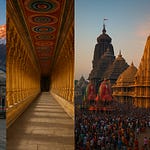Khatu Shyam Ji, one of the most revered deities in Hinduism, holds immense spiritual significance for millions of devotees across India and beyond. The temple dedicated to Khatu Shyam Ji is located in the town of Khatu in the Sikar district of Rajasthan, India. It is a major pilgrimage destination, particularly for followers of the deity, who is believed to be an incarnation of Lord Krishna.
History of Khatu Shyam
The story of Khatu Shyam Ji dates back to the Mahabharata era. According to legend:
Barbarik's Sacrifice: Barbarik, the grandson of Bhima and son of Ghatotkacha, was an ardent devotee of Lord Krishna. He possessed divine powers and was gifted with three infallible arrows that could conquer the world. Barbarik vowed to support the weaker side in any battle, which led Lord Krishna to test his resolve.
Krishna's Test: Realizing Barbarik's potential to disrupt the balance of the Kurukshetra war, Lord Krishna asked for his head as a sacrifice. Barbarik willingly offered his head to Krishna as a mark of devotion. Impressed by his sacrifice, Krishna blessed him, declaring that Barbarik would be worshipped in the Kali Yuga as "Shyam," another name of Krishna.
Emergence of Khatu Shyam Ji: The head was later found buried in the Khatu region during the Kali Yuga and was enshrined in the temple after divine instructions in a dream to a local king.
Architecture of Khatu Shyam Temple
The Khatu Shyam Ji temple is a stunning example of Rajasthani temple architecture:
Marble and Gold Design: The temple is constructed primarily of white marble with intricate carvings and gold plating on the sanctum.
Ornate Entrance: The main entrance gate features intricate designs and depictions of deities.
Sanctum Sanctorum: The sanctum houses the idol of Khatu Shyam Ji, adorned with flowers, gold, and silver ornaments.
Large Prayer Hall: The temple features a spacious prayer hall, where devotees gather to sing bhajans (devotional songs).
Sacred Kund: The Shyam Kund, a holy water tank near the temple, is believed to be the spot where Barbarik's head was found.
Significance of Khatu Shyam Ji
Revered Deity: Khatu Shyam Ji is considered the "God of the Kaliyuga," who fulfills the wishes of his devotees.
Symbol of Sacrifice: The deity symbolizes selflessness, devotion, and sacrifice, as exemplified by Barbarik’s life.
Blessings of Strength and Wisdom: Devotees believe that worshipping Khatu Shyam Ji grants strength, wisdom, and the courage to overcome life’s challenges.
Historic Timeline
Mahabharata Era: Barbarik’s sacrifice and Lord Krishna’s blessing.
Kali Yuga: Discovery of the head in the Khatu region.
11th Century: The temple was established following divine revelations.
Modern Renovations: The temple has undergone multiple renovations over the years, most notably during the 20th century.
Religious and Spiritual Significance
Hindu Belief System: The temple is a key pilgrimage site for Vaishnavites and devotees of Krishna.
Devotion and Bhakti: The deity is associated with unwavering devotion to the divine.
Healing Powers: The temple is believed to have miraculous powers, and devotees flock here for physical and spiritual healing.
Rituals at Khatu Shyam Ji
Morning Aarti: The day begins with a grand aarti (prayer) and the unveiling of the deity’s idol.
Bhog Offerings: Devotees offer sweets, flowers, and bhog to the deity.
Shyam Rasoi: A free community kitchen serves meals to pilgrims.
Special Days: Festive days like Ekadashi and Phalgun Mela see grand celebrations with kirtans and processions.
Travel and Pilgrimage
Location: Khatu Shyam Ji temple is situated in the Sikar district of Rajasthan, about 80 km from Jaipur.
How to Reach:
By Air: The nearest airport is Jaipur International Airport.
By Train: The Ringas Junction is the closest railway station.
By Road: The temple is well-connected by road to major cities in Rajasthan.
Accommodations: Pilgrims can find dharamshalas (rest houses), budget hotels, and lodges in Khatu and nearby towns.
Annual Phalgun Mela
One of the most significant events at the temple is the Phalgun Mela, held during February or March. Devotees from across the country walk barefoot to the temple, singing bhajans and offering prayers.
Rituals and Customs
Shyam Baba’s Darshan: Devotees seek darshan (a holy glimpse) to gain blessings.
Chappan Bhog: A grand offering of 56 dishes is made to the deity during special occasions.
Manokamna (Wishes): It is believed that tying a thread at the temple premises fulfills devotees' wishes.
Khatu Shyam Ji temple is not just a place of worship; it is a center of spiritual enlightenment and faith. The deity’s legacy of sacrifice and devotion continues to inspire millions. Visiting the temple is a deeply transformative experience, blending devotion, culture, and history. Whether you seek spiritual solace, divine blessings, or a glimpse into India’s rich heritage, Khatu Shyam Ji offers it all.
4o










